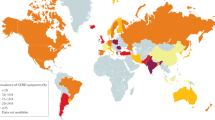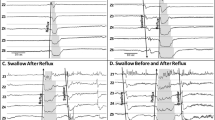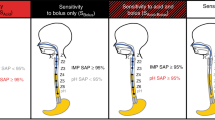Abstract
Classic techniques like videofluoroscopy, stationary manometry, and ambulatory 24 h pH-metry are routinely used in the clinic to study patients with dysphagia, chest pain and reflux-related symptoms. Although these techniques have been very useful over the years, both for diagnosis and for therapeutic guidance, there are still many patients with dysphagia or chest pain who remain undiagnosed even after testing, and patients with typical and atypical symptoms of gastroesophageal reflux disease, with normal pH-metry findings, who do not respond adequately to antisecretory therapy. Esophageal impedance monitoring is a new technique that can be used alone and in combination with pH-metry and manometry to evaluate bolus transport and all types of gastroesophageal reflux (acid and nonacid). This review describes the esophageal impedance monitoring technique and summarizes the published validation studies that compare impedance monitoring with other methods, as well as normal values and reproducibility of impedance patterns and their association with symptoms.
Key Points
-
Impedance recording is a technique that allows evaluation of bolus transit without the use of radiation, and the detection of all types of gastroesophageal reflux
-
Combined impedance–manometry recordings allow evaluation of bolus transit in patients with manometric abnormalities
-
Combined impedance–pH-metry allows for distinction between the different types of reflux: acid, weakly acidic, weakly alkaline, superimposed or gas
This is a preview of subscription content, access via your institution
Access options
Subscribe to this journal
Receive 12 print issues and online access
$209.00 per year
only $17.42 per issue
Buy this article
- Purchase on Springer Link
- Instant access to full article PDF
Prices may be subject to local taxes which are calculated during checkout




Similar content being viewed by others
References
Tutuian R and Castell DO (2005) Reflux monitoring: role of combined multichannel intraluminal impedance and pH. Gastrointest Endosc Clin N Am 15: 361–371
Van Herwaarden MA and Smout AJ (2000) Diagnosis of reflux disease. Baillieres Best Pract Res Clin Gastroenterol 14: 759–774
Emerenziani S and Sifrim D (2005) New developments in detection of gastroesophageal reflux. Curr Opin Gastroenterol 21: 450–453
Silny J (1991) Intraluminal multiple electric impedance procedure for measurement of gastrointestinal motility. J Gastrointest Motil 3: 151–162
Silny J et al. (1993) Verification of the intraluminal multiple electrical impedance measurement for recording of gastrointestinal motility. J Gastrointest Motil 5: 107–122
Sifrim D et al. (2004) Gastro-oesophageal reflux monitoring: review and consensus report on detection and definitions of acid, non-acid, and gas reflux. Gut 53: 1024–1031
Sifrim D et al. (1999) Patterns of gas and liquid reflux during transient lower oesophageal sphincter relaxation: a study using intraluminal electrical impedance. Gut 44: 47–54
Shay S and Richter J (2005) Direct comparison of impedance, manometry, and pH probe in detecting reflux before and after a meal. Dig Dis Sci 50: 584–590
Simren M et al. (2003) Relevance of ineffective oesophageal motility during oesophageal acid clearance. Gut 52: 784–790
Imam H et al. (2005) Bolus transit patterns in healthy subjects: a study using simultaneous impedance monitoring, videoesophagram, and esophageal manometry. Am J Physiol Gastrointest Liver Physiol 288: G1000–G1006
Dantas R et al. (2003) Esophageal volume clearance can be accurately assessed with intraluminal electrical impedance [abstract]. Gastroenterology 124 (Suppl S)
Sifrim D (2004) Acid, weakly acidic and non-acid gastro-oesophageal reflux: differences, prevalence and clinical relevance. Eur J Gastroenterol Hepatol 16: 823–830
Castell DO and Vela M (2001) Combined multichannel intraluminal impedance and pH-metry: an evolving technique to measure type and proximal extent of gastroesophageal reflux. Am J Med 111 (Suppl 8A): s157—s159
Zentilin P et al. (2004) Combined multichannel intraluminal impedance and pH-metry: a novel technique to improve detection of gastro-oesophageal reflux literature review. Dig Liver Dis 36: 565–569
Vaezi MF and Shay SS (2001) New techniques in measuring nonacidic esophageal reflux. Semin Thorac Cardiovasc Surg 13: 255–264
Shay SS et al. (2003) Acid rereflux: a review, emphasizing detection by impedance, manometry, and scintigraphy, and the impact on acid clearing pathophysiology as well as interpreting the pH record. Dig Dis Sci 48: 1–9
Sifrim D et al. (2001) Acid, nonacid, and gas reflux in patients with gastroesophageal reflux disease during ambulatory 24-hour pH–impedance recordings. Gastroenterology 120: 1588–1598
Sifrim D et al. (2002) Patients with gastroesophageal reflux disease have a selective increase of acid reflux when they have their habitual meals during 24-hr ambulatory pH–impedance recordings [abstract]. Gastroenterology 122: T1127
Zerbib F et al. (2005) Normal values and day-to-day variability of 24-h ambulatory oesophageal impedance–pH monitoring in a Belgian–French cohort of healthy subjects. Aliment Pharmacol Ther 22: 1011–1021
Shay S et al. (2004) Twenty-four hour ambulatory simultaneous impedance and pH monitoring: a multicenter report of normal values from 60 healthy volunteers. Am J Gastroenterol 99: 1037–1043
Alonso ML et al. (2005) 24-h esophageal ph–impedance monitoring in healthy preterm neonates. Normal values for acid, weakly acidic and alkaline gastroesophageal reflux [abstract]. Gastroenterology 4 (Suppl 2): a395
Bredenoord AJ et al. (2005) Reproducibility of multichannel intraluminal electrical impedance monitoring of gastroesophageal reflux. Am J Gastroenterol 100: 265–269
Vela MF et al. (2001) Simultaneous intraesophageal impedance and pH measurement of acid and nonacid gastroesophageal reflux: effect of omeprazole. Gastroenterology 120: 1599–1606
Sifrim D et al. (2002) Heartburn during ambulatory 24-hs pH–impedance recordings in patients with reflux disease “off” medication [abstract]. Gastroenterology 122: G432
Shay S et al. (2004) Twenty-four hour impedance and pH monitoring (24-hr Imp–pH) in the evaluation of GERD patients with persistent symptoms despite bid proton pump inhibitors (PPI): a multicenter study [abstract]. Gastroenterology 126 (Suppl 2): a324
Mainie I et al. (2004) Symptoms on PPI therapy associated with non-acid, acid or no reflux [abstract]. Am J Gastroenterol 99 (Suppl): s14
Sifrim D (2005) Relevance of volume and proximal extent of reflux in gastro-oesophageal reflux disease. Gut 54: 175–178
Bredenoord AJ et al. (2005) Determinants of perception of heartburn and regurgitation. Gut [doi: 10.1136/gut.2005.074690]
Katz P et al. (2005) Reflux symptoms on twice daily (BID) proton pump inhibitor (PPI) associated with non acid reflux; a manifestation of hypersensitive esophagus [abstract]? Gastroenterology 128 (Suppl 2): a130
Wenzl TG et al. (1999) Gastroesophageal reflux and respiratory phenomena in infants: status of the intraluminal impedance technique. J Pediatr Gastroenterol Nutr 28: 423–428
Wenzl TG et al. (2001) Association of apnea and nonacid gastroesophageal reflux in infants: Investigations with the intraluminal impedance technique. Pediatr Pulmonol 31: 144–149
Peter CS et al. (2002) Gastroesophageal reflux and apnea of prematurity: no temporal relationship. Pediatrics 109: 8–11
Mousa H et al. (2005) Testing the association between gastroesophageal reflux and apnea in infants. J Pediatr Gastroenterol Nutr 41: 169–177
Sifrim D et al. (2005) Weakly acidic reflux in patients with chronic unexplained cough during 24 hour pressure, pH, and impedance monitoring. Gut 54: 449–454
Fontana GA and Pistolesi M (2003) Cough. 3: chronic cough and gastro-oesophageal reflux. Thorax 58: 1092–1095
Mainie I et al. (2005) Fundoplication eliminates chronic cough due to non-acid reflux identified by impedance pH monitoring. Thorax 60: 521–523
Kawamura O et al. (2004) Physical and pH properties of gastroesophagopharyngeal refluxate: a 24-hour simultaneous ambulatory impedance and pH monitoring study. Am J Gastroenterol 99: 1000–1010
Srinivasan R et al. (2001) Esophageal function testing using multichannel intraluminal impedance. Am J Physiol Gastrointest Liver Physiol 280: G457–G462
Tutuian R et al. (2003) Esophageal function testing with combined multichannel intraluminal impedance and manometry: multicenter study in healthy volunteers. Clin Gastroenterol Hepatol 1: 174–182
Nguyen NQ et al. (2005) Assessment of oesophageal motor function using combined perfusion manometry and multi-channel intra-luminal impedance measurement in normal subjects. Neurogastroenterol Motil 17: 458–465
Tutuian R and Castell DO (2004) Clarification of the esophageal function defect in patients with manometric ineffective esophageal motility: studies using combined impedance–manometry. Clin Gastroenterol Hepatol 2: 230–236
Tutuian R and Castell DO (2004) Combined multichannel intraluminal impedance and manometry clarifies esophageal function abnormalities: study in 350 patients. Am J Gastroenterol 99: 1011–1019
Bredenoord AJ et al. (2004) Aerophagia, gastric, and supragastric belching: a study using intraluminal electrical impedance monitoring. Gut 53: 1561–1565
Zentilin P et al. (2005) Air swallowing can be responsible for non-response of heartburn to high-dose proton pump inhibitor. Dig Liver Dis 37: 454–457
Tutuian R and Castell DO (2004) Rumination documented by using combined multichannel intraluminal impedance and manometry. Clin Gastroenterol Hepatol 2: 340–343
Pandolfino et al. (2005) Measuring EGJ opening patterns using high resolution intraluminal impedance. Neurogastroenterol Motil 17: 200–206
Omari et al. (2006) Assessment of intraluminal impedance for the detection of pharyngeal bolus flow during swallowing in healthy adults. Am J Physiol Gastrointest Liver Physiol 290: G183–G188
Sifrim D et al. (2005) Baclofen reduces weakly acidic reflux in ambulant patients with GERD [abstract]. Gastroenterology 28 (Suppl 2)
Zentilin P et al. (2005) An evaluation of the antireflux properties of sodium alginate by means of combined multichannel intraluminal impedance and pH-metry. Aliment Pharmacol Ther 21: 29–34
Zhang X et al. (2003) Acid and non-acid gastroesophageal reflux after endoscopic gastroplication. Evaluation of the antireflux barrier function with 24hs-pH–impedance [abstract]. Gastroenterology 124 (Suppl S)
Mainie I et al. (2005) Reflux (acid or non-acid) detected by multichannel intraluminal impedance–pH testing predicts good symptom response from fundoplication [abstract]. Gastroenterology 128 (Suppl 2)
Author information
Authors and Affiliations
Corresponding author
Ethics declarations
Competing interests
The authors declare no competing financial interests.
Rights and permissions
About this article
Cite this article
Sifrim, D., Blondeau, K. Technology Insight: the role of impedance testing for esophageal disorders. Nat Rev Gastroenterol Hepatol 3, 210–219 (2006). https://doi.org/10.1038/ncpgasthep0446
Received:
Accepted:
Issue Date:
DOI: https://doi.org/10.1038/ncpgasthep0446
This article is cited by
-
Can Impedance-pH Testing on Medications Reliably Identify Patients with GERD as Defined by Pathologic Esophageal Acid Exposure off Medications?
Journal of Gastrointestinal Surgery (2019)
-
Impedance-pH monitoring on medications does not reliably confirm the presence of gastroesophageal reflux disease in patients referred for antireflux surgery
Surgical Endoscopy (2018)
-
Azithromycin Reduces Gastroesophageal Reflux and Aspiration in Lung Transplant Recipients
Digestive Diseases and Sciences (2009)
-
Laryngeal manifestations of gastroesophageal reflux disease
Current Gastroenterology Reports (2008)



